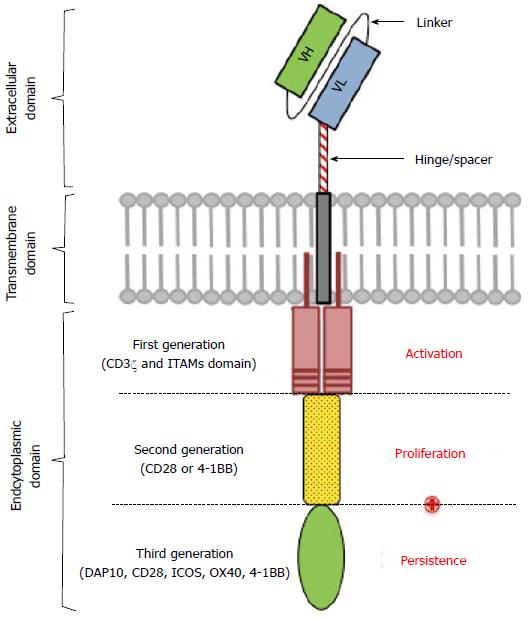Copyright
©The Author(s) 2015.
World J Stem Cells. Aug 26, 2015; 7(7): 1022-1038
Published online Aug 26, 2015. doi: 10.4252/wjsc.v7.i7.1022
Published online Aug 26, 2015. doi: 10.4252/wjsc.v7.i7.1022
Figure 1 Schema of the general structure of a chimeric antigen receptor.
The antigen recognition moiety is composed of the variable domain of heavy (VH) and light (VL) chains of the antibody, specific for a native tumor-associated antigen expressed on the surface of malignant cells. This structure is connected to the cytoplasm by a spacer, generally derived from CD8 or CD28 subunits, and a transmembrane domain. First generation chimeric antigen receptor T cells were solely composed of a single intracellular domain generally derived from CD3ζ subunit and its immunoreceptor tyrosine-based activation motifs (ITAMs), essential for Lck recruitment and full downstream T cell receptor-like signaling transduction. In order to improve engineered T cells proliferation and persistence, investigators introduced successively one (second generation) or ≥ 2 additional intracellular signaling domains (third generation). ICOS: Inducible costimulator.
Figure 2 Schema of the transposon/transposase “sleeping beauty” system.
A: The genetic cargo of a first plasmid (plasmid 1) is the chimeric antigen receptor (CAR) (anti-CD19 CD3ζ-CD28) flanked by inverted/short direct repeats (IR/DR). The whole set composed the transposon. The enzyme transposase is loaded in a second plasmid, which is specific of the IR/DR sequence; B: Materials of the two plasmids are fused together by electroporation, an electric current opening pores or channels at the cell surface. Transposase binds to the IR/DR sequences; C: The enzyme cut out of the plasmid the flanked sequences (CAR transgene with its promotor) and transfect the genetic cargo into a random DNA sequence of the recipient (T cell).
- Citation: Heiblig M, Elhamri M, Michallet M, Thomas X. Adoptive immunotherapy for acute leukemia: New insights in chimeric antigen receptors. World J Stem Cells 2015; 7(7): 1022-1038
- URL: https://www.wjgnet.com/1948-0210/full/v7/i7/1022.htm
- DOI: https://dx.doi.org/10.4252/wjsc.v7.i7.1022










